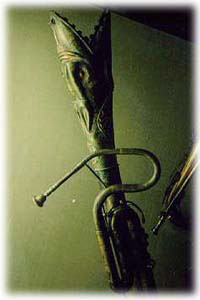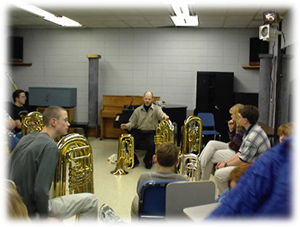

compiled by
Dr. Jeffrey Funderburk
This graded list represents a sampling of music that can be used as a 'jumping off point' for study of solo tuba literature. It is by no means complete and generally attempts to use works which are generally available and widely known. For a far more complete and helpful text, consult 'The Tuba Source Book' published by Indiana University Press.
Grades I-II
Benson, Warren. Arioso (1954). Belwin-Mills.
1 movt. 1'30". Generally lower tess. than normal for this level,D1-F3. Accomp.moderate.
Song style requires good legato style and use of fourth valve or 'false tones'.
Handel, G.F./Ostrander, A. Arm Ye Brave. Edition Musicus (p.1959).
Aria. 3'30". B1-F3. Accomp. easy.
Excellent melodic piece for work on legato. Lower notes may be played up an octave to simplify range.
Handel, G.F./Morris. Revenge! Timotheus Cries! Ludwig (1970).
Aria. 1'30". C#2-E3. Accomp. easy.
Key of D# may be troublesome for some and a final sixteenth note passage. Style and dynamics are the important aspects of this work.
Petrie, H.W./Buchtel. Asleep in the Deep (1958). Kjos.
1 movt. 2'00". G1-C3. Accomp. mod.
One of the most famous 'tuba melodies'. The arrangement is in 6/8 in the key of Eb.
Purcell, Henry/Ostrander. Arise Ye Subterranean Winds. Edition Musicus (1959).
Aria. 2'30". G1-F3. Accomp. easy.
An excellent baroque transcription with some sixteenth note runs.
Purcell, Henry/Morris. Recitative, Song and Chorus. Southern (1972).
Aria with recitative and chorus. 4' 30". C2-G3. Easy piano.
Musically this is more demanding than the technique required suggests.
Schumann, Robert/Holmes. Jolly Peasant. Rubank (1966).
Theme and variations. 1'30". C2-F3. Accomp. moderate.
Simple theme which should be fun for the player.
Grade III
Arnold, Malcolm. Fantasy for Tuba (1969). Faber Music.
1 movt. 5'00". F1-C4. No accomp.
Fine unaccompanied work which is very listenable. The primary demand is on range.
Bach, J. S./Bell, W. Air and Bourree. Carl Fischer (1937).
2 movt. 3'30". G1-Bb3. Accomp. moderate.
One of the oldest and finest transcriptions for tuba. The first movement is challenging musically and on a basis of breath control. The second movement is technically demanding.
2 movts. 6' 00". F1-B3. Accomp. moderate.
This composition demands drive and intensity for a successful performance. This should prove challenging for the better high school player.
Holmes, Paul. Lento (1961). Shawnee.
1 movt. 4'00". E1-D4. Accomp. moderate.
Good legato playing with contrasting middle section more articulated. Only real challenge of this composition is range and musical interpretation.
Mozart, W.A./Morris. O Isis and Osiris. Brass Press (1971).
Aria. 3'00". F1-C4. Easy accomp
Beautiful melody for musical interpretation with only technical demand being the somewhat extensive range.
Perantoni, Dan. Master Solos Intermediate Level. Hal Leonard.
An excellent collection of solos in varying styles with moderate accompaniment. A tape recording is available which has the work performed on one side and only the accompaniment on the flip side.
Grade IV
Beversdorf, Thomas. Sonata for Bass Tuba (1962). Southern.
3 movts. 15'00". F1-A3. Accomp. moderately difficult.
A major work for tuba which exploits the most comfortable range of the instrument. Both technically and musically demanding.
Capuzzi, Antonio/Catelinet. Andante and Rondo. Hinrichsen (1967).
2 movt. 8'00". F1-G3. Accomp. moderately difficult.
Rather extended transcription that can prove quite challenging. Extended running sixteenth passages complicate breath control in the second movement. Some ossia passages may be used to extend the range both higher and lower.
Haddad, Don. Suite for Tuba (1966). Shawnee.
3 movts. 8'00". Ab1-C4. Accomp. moderate.
Excellent work of varied styles that should prove enjoyable for both player and listener.
Hartley, Walter. Sonatina (1961). Fema Music.
3 movts. 6'00". G1-A3. Accomp. moderately difficult.
Excellent work that puts demands on areas of smooth large interval slurs and running passages.
Lebedev, A. Concerto in One Movement (1960). Edition Musicus.
1 movt. 6'00". E1-C4. Accomp. moderate.
Many musical and technical demands including a three-octave cadenza. Ossia parts available that would extend the range.
Stabile, James. Sonata (1970). WIM.
3 movts. 8'00". G1-Db4. Accomp. moderate.
Good writing in a comfortable range. The first movement is much more demanding than the remaining two. The second and third movements should be performed without break between though this is not indicated on either piano or tuba part.
Grade V
Hindemith, Paul. Sonate for Bass Tuba and Piano (1955). Schott.
3 movts. 12'00". G1-C4. Very difficult piano!!
Ensemble problems and musical/interpretive problems are the primary difficulty for the tubist. The third movement is one of the most difficult accompaniment parts in the repetoire for the pianist. One of the major works available to the tubist.
Koetsier, Jan. Sonatina (1970). Domenus.
3 movts. 7'00". G1-Eb4. Accomp.moderately difficult.
An excellent work for both performer and audience. A challenging composition in all areas making use of varying styles in each movement.
Sauter, Eddie. Conjectures (1968). Mentor.
1 movt. 9'00". F#1-E4. Accomp. moderately difficult.
Extremely rubato with tempo changes almost every measure. Highly stylized music which requires a polished performer.
Sibbing, Robert. Sonata (1963). Presser.
3 movts. 11'00". F1-C4. Accomp. moderately difficult.
An excellent work featuring superb writing for the tuba.
Spillman, Robert. Concerto (1962). Edition Musicus.
4 movts. 15'00". E1-F4. Accomp. moderate.
Technically demanding with high tessitura, double tongue passages, large intervals, and endurance problems. An excellent work in a conservative contemporary style.
Stevens, Halsey. Sonatina (1960). Southern.
3 movts. 10'00". G1-F4. Difficult accomp.
Excellent work which is very rhythmically interesting.
Vaughan Willams, Ralph. Concerto for Bass Tuba (1955). Oxford.
3 movt. 15'00". Eb1-F4. Very difficult piano reduction.
A major standard composition. There are a great many errors in the published part that should be corrected prior to performance, though it is possible to perform it successfully without corrections.
Wilder, Alec. Suite No. 1 (Effie Suite) (1968). Margun Music.
6 movts. 11'00". F1-E4. Difficult accomp.
Very effective writing which is generally technically oriented. Several possiblities of shorter combinations of these movements exists.
Grade VI
Bozza, Eugene. Concertino (1967). A. Leduc.
3 movts. 17'00" F1-Ab4. Difficult accomp.
Very demanding in every regard. Most appropriately performed on the smaller tubas, i.e. F and Eb.
Broughton, Bruce. Sonata(1976). Helicon Music.
3 movts. 12'00". D0-Eb4. Difficult accomp.
A very exciting work that is highly challenging from all respects, but one wish is very rewarding for performer and audience. Style might be considered as 'Neo-romantic'. Originally entitled Concerto as it was first scored for orchestra, the work is excellent with piano, orchestra, or band accompaniments. A must for the professional performer.
Kraft, William. Encounters II for Solo Tuba (1970). MCA Music.
1 movt. with multiple sections. 6'00". C0-Bb4. No accomp.
A tremendously difficult work for both technique and interpretation, however, well worth the effort. A true virtuoso composition.
Payne, Frank Lynn. Sonata(1979). Shawnee Press.
4 movts. 8'30". C#0-F#4. Difficult accomp.
A very exciting, constantly driving work with tremendous difficulty in the area of ensemble. The second movement makes use of some 'free notation' but this should present no problem for any performer at a level to consider this piece. Mildly contemporary in style.
White, Donald. Sonata(1979). Ludwig.
3 movts. 12'00". F0-F4. Difficult accomp.
Ensemble is of particular concern especially through the third movement which spends much of its time in 7/8 at a tempo of 200 to the quarter note. Through extrememly demanding on each performer, the results are worthwhile.
Copyright © 2003 Dr. Jeffrey Funderburk